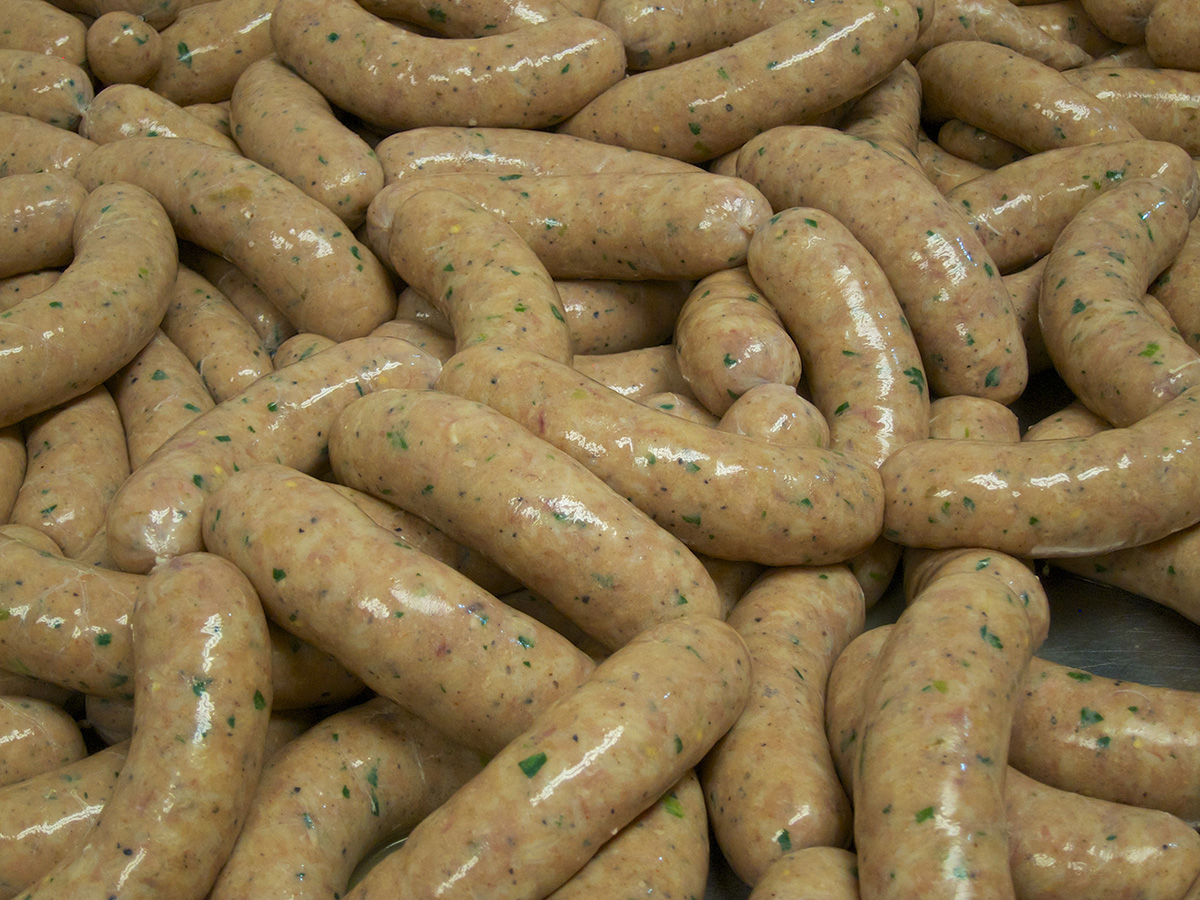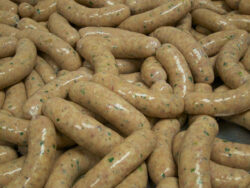Boudin
Boudin is a Cajun sausage made of meat and rice typically consumed with the filling removed from the casing and often squeezed directly into the mouth.

Wikimedia Commons
Boudin Blanc prepared by Cochon Butcher in New Orleans, 2012. Tom Head, photographer.
Boudin, a modest sausage crafted from cooked pork, rice, onions, and an invigorating touch of cayenne, features a meat-and-rice mixture prepared before being enclosed in its casing. Traditionally, the links are steamed or simmered, yielding an elastic casing enveloping a relatively loose filling. The distinctive aspect of boudin lies in the way the filling is typically eaten by extruding the filling from the casing, often squeezed directly into the mouth. An increasingly common approach involves removing the filling from the casing for creative applications in diverse dishes, spanning from boudin-stuffed quail to boudin-infused burgers. Radiating outward from Lafayette, within the region recognized as Acadiana or “Cajun Country,” specialized meat markets, grocery stores, standalone boudin shops, and convenience stores offer boudin based on recipes passed down through generations. Other regions of the state, and even other states, have also seen boudin come onto their culinary scenes as the popularity of the sausage continues to expand.
In the past, two variants of boudin existed: boudin rouge, or red boudin containing blood, and boudin blanc, or white boudin. However, due to stringent food processing regulations and evolving preferences, boudin rouge has largely declined in popularity and is seldom found on the market.
Boudin traces its roots to France, French Creoles, French Acadians, and Cajuns. In France, dating back to the 1300s, two types of boudin gained popularity. One was boudin noir, (black boudin), a blood sausage. The other was boudin blanc, a smooth paste of meat and other ingredients like acorns, poached in a terrine. These French boudins were a culinary mainstay, accompanying French colonization wherever it ventured.
As French people settled in Louisiana, the exact recipes might have evolved, yet the general association with boudin as a desirable and familiar delicacy persisted. The earliest recorded mention of boudin in the Louisiana Territory dates to May 9, 1805. The journals of Lewis and Clark recount how their French fur trapper, Toussaint Charbonneau, fashioned a buffalo intestine into a casing, filled it with meat and kidney suet, baptized it in the Missouri River with “two dips and a flirt,” then boiled and fried it in bear grease. This innovative creation was dubbed “boudin” and celebrated as a “forest delicacy.”
As Louisiana achieved statehood in 1812, displaced rural French Acadians and their descendants continued to move into the woods, prairies, and bayou lands of southwest Louisiana, and their food traditions followed. One of those traditions was the boucherie, a communal stock animal butchering. Boucheries were festive undertakings as the animal (most frequently a hog) was euthanized, cleaned, slaughtered, cooked, and parceled out to participating families. Individuals accepted their assigned roles. One was to collect fresh blood from the pig and hold it until the butchering was complete, leaving the heart, head, offal, and other cleaned bits and guts. This was when boudin rouge, one of the more prized items of the boucherie, was made. The pork was cooked with onions, green onions, parsley, and seasonings, and then the blood was slowly stirred into the warm mixture before it was expertly stuffed by hand. In time, the adherence to boudin rouge from the boucheries transitioned to what we now know as Cajun boudin without the blood and with the inclusion of rice and cayenne.
Understanding the diverse culinary influences that were pivotal in shaping Cajun boudin’s evolution is crucial. Among these contributions, the introduction of cayenne pepper from Spanish and Afro-Caribbean sources stands out prominently. Another example of these transformative influences originates from German traditions. Between the 1870s and 1890s, a notable wave of German immigrants arrived in Louisiana, coinciding with the expansion of rice cultivation in the Cajun parishes. These immigrants not only bolstered the emerging rice industry but also brought their renowned expertise in sausage-making to the region. One German sausage, known as Blutwurst, is a blood sausage comprising oats, pork, and various seasonings. It essentially mirrors boudin rouge in composition.
Although it clearly happened earlier, the initial recorded instance of boudin in Louisiana incorporating rice appeared in the March 4, 1939, issue of the Lafayette Daily Advertiser. In this publication, boudin is categorized as one of the “Rice Dishes of Louisiana” within the “Farm Topics” section, marking a significant step in the evolution of boudin’s ingredients.
Originally tied to intermittent boucheries, boudin’s prominence progressed with rice, cayenne, and refrigeration. Arneastor Johnson popularized commercial sales in the 1940s at Johnson’s Grocery, in Eunice. Earlier instances include Miss Daisy Broussard’s boudin (1926) at Mouton Mercantile Co., in Lafayette; Crowley Cold Storage Meat Market’s white boudin (1934); Landry’s French Market offerings (1938); and Mason’s Grocery’s “Country Style Boudin.” Johnson’s hot boudin changed the game, drawing long lines, inspiring imitators. By the 1950s and ‘60s, “Cajun,” “Hot,” or “Country Boudin” gained popularity, securing Cajun boudin’s culinary significance and wild popularity. Today, passions surrounding who has the “best” boudin run deep, and a multitude of boudin-centered festivals and competitions are held annually throughout Louisiana.
The transfer and evolution of boudin from France to the whole French colonial network occurred differently in Louisiana. The Creolization process—where Acadians-turned-Cajuns accepted Native American, Spanish, Afro-Caribbean, and German practices—led to a wholly new approach to making boudin, using pork exclusively, rice, and cayenne for heat. There would not be Cajun boudin without French boudin, but the original stands as a bit of an afterthought when set side-by-side to the esteem of those links held in steaming pots in the gas stations, meat markets, grocery stores, and festivals of Acadiana.
